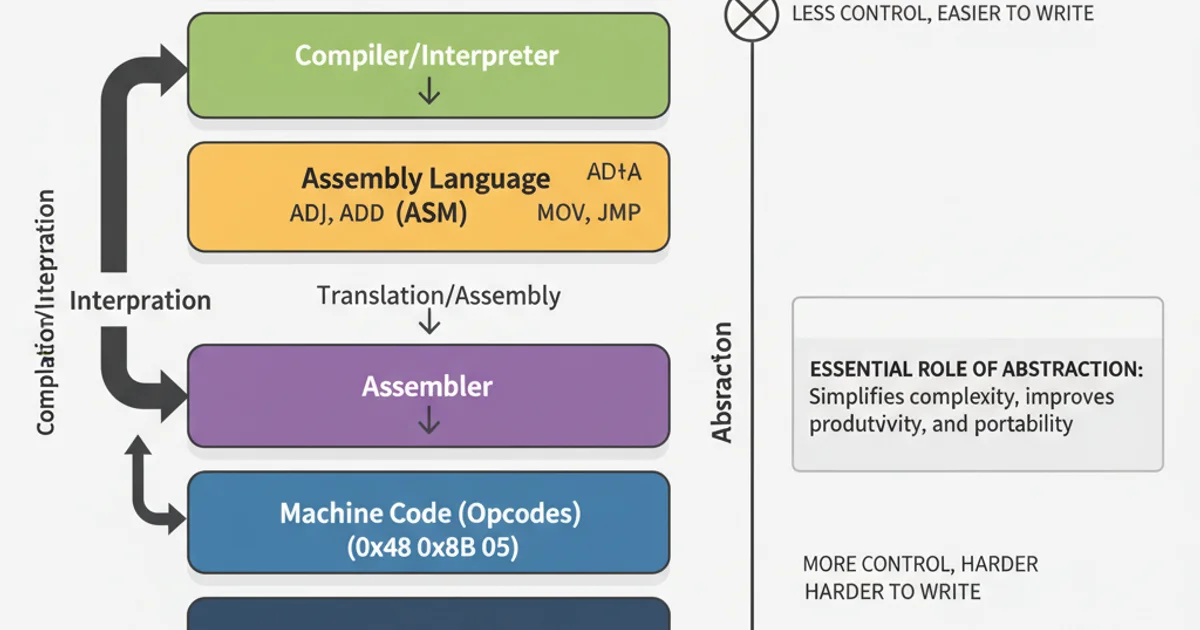Is there any benefit to writing an entire operating system in binary code?
Categories:
The Feasibility and Folly of Writing an OS Entirely in Binary Code

Explore the theoretical benefits and overwhelming practical challenges of developing an operating system directly in binary, examining why modern development eschews this approach.
The idea of writing an entire operating system (OS) in raw binary code, without the aid of assemblers or compilers, is a fascinating thought experiment. While theoretically possible, it presents an array of insurmountable practical challenges that make it an utterly impractical endeavor in modern computing. This article delves into the hypothetical benefits, the stark realities, and the reasons why such an approach has been abandoned in favor of higher-level abstractions.
Theoretical 'Benefits' of Pure Binary Development
On the surface, one might imagine a few theoretical advantages to writing an OS directly in binary. These 'benefits' are largely academic and quickly dissolve under scrutiny, but they form the basis of the initial thought experiment.
flowchart TD
A[Start with Binary] --> B{No Compiler/Assembler Overhead}
B --> C[Absolute Control over Hardware]
C --> D[Potentially Smallest Footprint]
D --> E[No Abstraction Layers]
E --> F[Direct CPU Interaction]
F --> G[End Theoretical Benefits]Theoretical advantages of writing an OS in pure binary
- Absolute Control and Minimal Overhead: Writing directly in binary would, in theory, grant the developer unparalleled control over every single bit and byte executed by the CPU. There would be no compiler optimizations (or mis-optimizations), no assembler directives, and no runtime overhead introduced by higher-level language constructs. This could lead to the absolute smallest possible code footprint and potentially the fastest execution, as every instruction is precisely what the developer intended.
- Deepest Understanding of Hardware: Such an exercise would force an intimate understanding of the CPU's instruction set architecture (ISA), memory management unit (MMU), and peripheral interfaces at their most fundamental level. This deep knowledge could, hypothetically, lead to highly optimized code tailored exactly to the specific hardware.
However, these 'benefits' are quickly overshadowed by the practical impossibilities.
The Overwhelming Practical Challenges
The theoretical benefits are dwarfed by the immense practical difficulties. Modern operating systems are incredibly complex, managing billions of operations per second, interacting with diverse hardware, and supporting a multitude of applications. Attempting to manage this complexity at the binary level is not just difficult; it's virtually impossible for any human.
flowchart TD
A[Start] --> B{Human Error Rate}
B --> C[Debugging Impossibility]
C --> D[Maintenance Nightmare]
D --> E[Lack of Abstraction]
E --> F[Portability Zero]
F --> G[Development Time Infinite]
G --> H[End Practical Challenges]Major practical challenges of binary OS development
- Extreme Complexity and Human Error: Even the simplest CPU instruction is represented by a sequence of binary digits. A typical OS contains millions of lines of code. Translating high-level logic (like 'allocate memory' or 'read from disk') into the correct sequence of binary opcodes, memory addresses, and data values is an error-prone task beyond human capability. A single misplaced bit could crash the entire system.
- Debugging is Impossible: How would one debug a system written entirely in binary? There would be no source code to reference, no symbolic debugger, and no meaningful stack traces. Identifying a bug would involve painstakingly examining raw memory dumps and CPU registers, trying to decipher the intent behind sequences of 0s and 1s.
- Maintenance and Collaboration Nightmare: Modifying or extending such an OS would be an exercise in futility. Understanding existing binary code, especially code written by someone else (or even oneself after a short period), is incredibly difficult. Collaboration among developers would be non-existent.
- Lack of Abstraction: Higher-level languages and assemblers provide crucial abstractions that map human-readable concepts to machine instructions. Without these, every single operation, from arithmetic to memory access, must be manually encoded. This makes development excruciatingly slow and inefficient.
- Zero Portability: Binary code is specific to a particular CPU architecture (e.g., x86, ARM). An OS written in binary for one architecture would be completely incompatible with another, requiring a full rewrite.
- Development Time: The time required to develop even a rudimentary OS in pure binary would be astronomical, likely exceeding the lifespan of the developers involved. The cost would be prohibitive.
Why Abstraction Layers are Essential
The evolution of programming languages and tools is a testament to the necessity of abstraction. Compilers and assemblers are sophisticated tools that bridge the gap between human-readable code and machine-executable instructions. They handle the tedious, error-prone task of translation, allowing developers to focus on logic and design rather than individual bits.

The essential role of abstraction layers in software development
Modern OS development relies on a stack of abstractions:
- High-Level Languages (C, C++): Provide powerful constructs, data structures, and control flow mechanisms that map complex logic to efficient machine code.
- Compilers: Translate high-level code into assembly language or directly into machine code, performing optimizations along the way.
- Assembly Language: A symbolic representation of machine code, offering a human-readable way to interact directly with CPU instructions when necessary (e.g., for bootloaders or critical performance-sensitive routines).
- Assemblers: Translate assembly language into machine code (binary).
- Linkers: Combine various compiled and assembled code modules into a single executable binary.
Each layer reduces complexity and improves productivity, making the development of robust and feature-rich operating systems feasible.
; Example of a simple assembly instruction
MOV AX, 0B800h ; Move the hexadecimal value 0B800h into the AX register
MOV ES, AX ; Move the content of AX into the ES segment register
MOV BYTE PTR [ES:0], 'H' ; Write character 'H' to video memory
Assembly language provides a human-readable abstraction over raw binary.